The Kleingers Group Wins 2022 ACEC Engineering Excellence Award
The Kleingers Group has received one of The American Council of Engineering Companies of Ohio‘s (ACEC) 2022 Outstanding Awards for the Blue Ash Road Corridor Improvements project. This redesign and beautification project was developed by transportation engineers Nick Yeretzian, Sarah Fraser, Mark Nolt, and Travis Hunt. The ACEC Ohio Engineering Excellence Awards will take place on March 10, 2022, in Columbus, Ohio.
The Kleingers Group identified the safety shortcomings of the corridor and was instrumental in securing funding the city needed for improvements. Some primary causes of unsafe conditions and other deficits included on-street parking, lack of adequate lighting, inadequate traffic signals, and deficient railroad preemption equipment. Design challenges were addressed and resolved through input and coordination with the community and other stakeholders, including utility providers. The design team, working with The City of Deer Park, conjoined the needed safety improvement elements with aesthetic enhancements to promote economic growth for the benefit of the surrounding community. The transformation includes reverse angled parking, a road diet, curb bump-outs, and site amenities, including bike racks, benches, and planters. Growth and viability are now inevitable due to proper planning, community engagement, and utilizing existing engineering technologies and techniques. This project proves that it is possible to provide sustained value to the communities we serve.
Read more about the Blue Ash Road Corridor Improvements project here.
Silverton Small Area Plan – Cincinnati Design Awards Winner
Silverton Small Area Plan wins Cincinnati Design Awards For Landscape Architecture & Community Planning
The Small Area Plan for the Village of Silverton promotes an active streetscape, provides for civic green space, and creates a more welcoming and walkable downtown. The design process included multiple stages of community engagement which began with a streetscape walk consisting of Village staff and focus group members to garner ideas for the future vision of the Plainfield Road streetscape. Public engagement continued with design charrettes and public open houses which were critical in creating the vision for the streetscape improvements for the diverse community.
To provide the Village of Silverton with a beautiful, pedestrian friendly streetscape promoting community building, the plan includes a Silverton gateway arch, a new pocket park, multiple streetscape parklets, a civic green with a pavilion for concerts, and community movie nights. Streetscape amenities include new streetscape pavement, pavers, planters, seating, art installations, lighting, parking, accessibility, bike racks, and Village branding.
The design was brought to life by creating extensive computer rendered 3D model videos. The rendered videos show the proposed improvements as if you were walking down the street. These videos helped to raise awareness of the plan and garner community support, promote economic development on the Village’s website, and helped successfully gain funding.
The Silverton Small Area Plan has created a meaningful impact on the community by creating a clear vision for the future streetscape and has already garnered additional funding to construct these proposed improvements.
Project Team
Urban Planner: Jay Stewart – Stewart Land Use
Landscape Architect:
Lynne Nischwitz – Lead Landscape Architect – The Kleingers Group; Jessica Rybolt – Landscape Designer; Dan Schneider – Landscape Architect
Other:
Tom Carroll – Silverton Village Manager
Read more about the award winning Silverton Small Area Plan at CincinnatiDesignAwards.com
10 Things to Consider When Planning a Sports Park
It’s not every day that an Owner takes on planning a 100+ acre sports park, but when the scenario arises, The Kleingers Group brings proven experience to the team. Over the years, Kleingers has designed a number of large-scale sports parks and has found that many of the same considerations tend to come up during our design process. We would like to share with you what to consider before you take on your sports park design.
1. Connect to Existing Community Assets
Creating transportation linkages to other community resources such as parks, schools, YMCAs, and more will encourage participation at the new development. Pursue ways to blend the new park with its surroundings and work with neighbors and stakeholders to build support for the project. Leverage connections through existing infrastructure like trailways, complete streets, and other multi-modal systems will provide easy access for bicyclists and pedestrians who visit the facility.
2. Create a Site that is Safe, Easy to Use, and Navigate
Speaking of connecting the site with pedestrians, it’s also important to design ways to keep them safe, especially from vehicular traffic. Maintain separate vehicle travel zones and pedestrian travel zones when possible and provide for safe and clearly marked crosswalks to help minimize conflicts. Branding, wayfinding, and creative use of landscape theming will help visitors with vehicles travel to their destination within the site more efficiently while minimizing user frustration.
Oftentimes, large sports complexes lack adequate wayfinding due to oversight or budget concerns. Proper wayfinding design can help users get to where they need to be while also creating a recognizable brand for the sports park and the associated owner.
3. All Sports Park Owners are in the Parking Business
Did you know that many competitive organizations that bring tournaments to sports parks require minimum parking per event? Organizers hosting tournaments require anywhere between 50-100 spaces per field, some require even more. Believe it or not, sports park owners are in the parking business. Visitors have high expectations that parking should be easy and accessing their field shouldn’t be a hassle. Tournament organizers must meet the demands of their clients, which means balancing the site’s infrastructure is important to everyone’s bottom line. Planning for enough parking close to destination points within the design allows for better traffic flow and provides better ADA access throughout the site. The site layout needs to balance ease of access without being interrupted by large parking areas, or losing the vibrancy of an active and energized park.
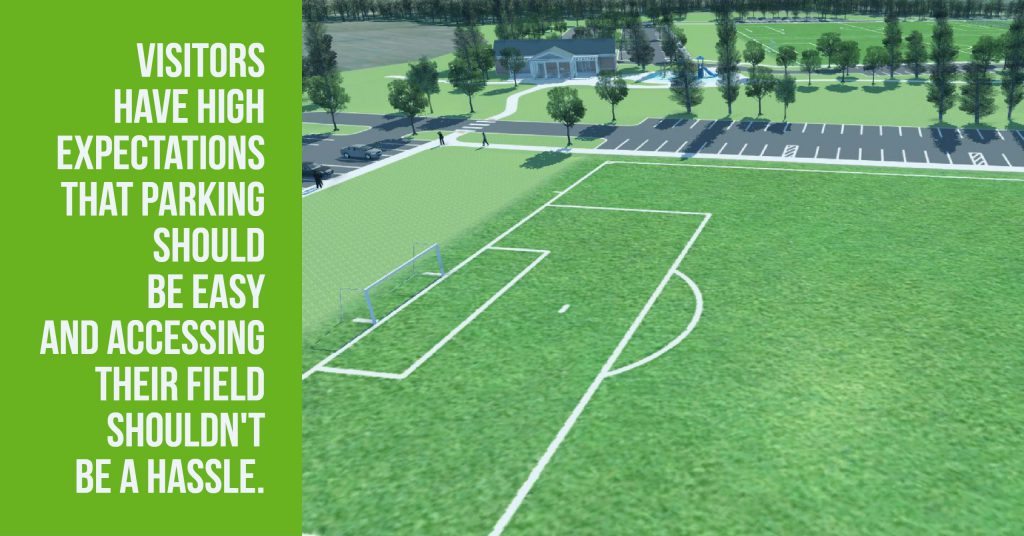
4. Plan for Flexibility: Master Planning the Site for Optimum Use
Creating a park with the most flexible layouts will mean more options for end-users. Engineering the field grading is a key component. Fields should be carefully engineered to accommodate high-end games and large events with the ability to host smaller games within the same space without compromising the playable area, including crowns and field orientation.
Master planning a complex for multiple sports provides flexibility when attracting special events. Understanding how to plan for and design sports parks for flexibility amongst sports, whether soccer, football, lacrosse, rugby, Australian football, ultimate frisbee, baseball, softball, or cricket will attract a larger audience. Knowledge of national sports trends will allow the field designer to guide a client through the planning stages while meeting their needs and measured desires within the area.
5. Coordinate with Local Municipalities
Working with local interests and shareholders during the design process helps to ensure that everyone has a voice in the process of designing the sports park. Creating opportunities for partnerships early will help generate buy-in from key stakeholders and community members. Our experience in working through this relationship helps guide programming, affordability, and ultimately desired priorities.
6. Plan for Extra Traffic in the Area
More often than not, any new development brings additional traffic to a site. Traffic engineers can provide traffic studies to better understand current traffic conditions and anticipated changes and recommendations.
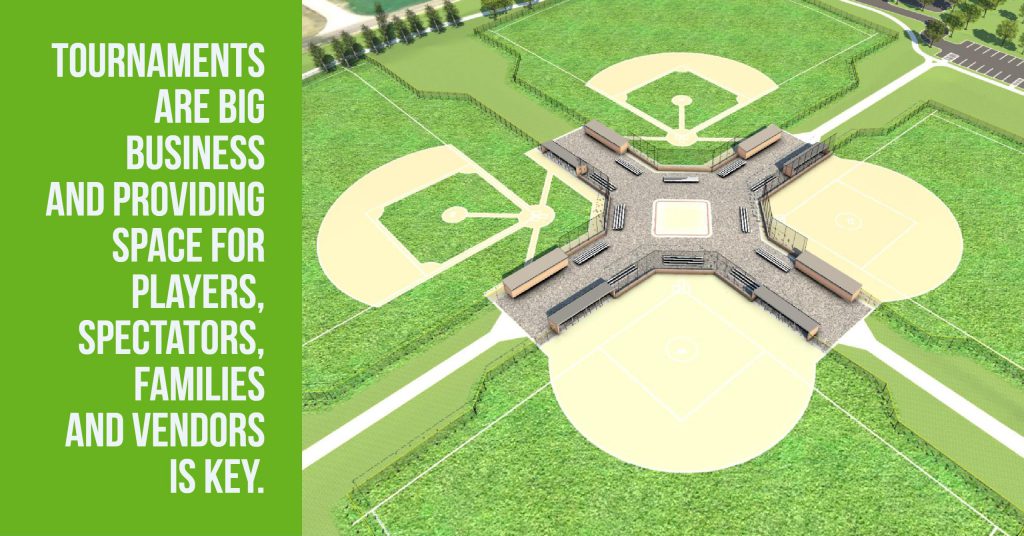
7. Sports Engineering is Key: Grading, Drainage & Field Performance Will Keep Them Coming Back
Creating space for tournaments is big business and retaining that business helps any sports park be successful. If the grading, slopes, drainage, playing surfaces, and other amenities are not designed properly, tournament organizations will take their business down the road to the competing sports park. Competitive organizations have a business to run and their business model depends on feedback from players and parents who use the fields, facilities, and park amenities at these events. Positive survey feedback will increase the chances that they return again for another event.
8. Plan for Attendees Who are not Players or Spectators
A large portion of the sports park business is creating a fun and comfortable experience for attendees. Creating spaces, such as playgrounds, within eyesight of a group of playing fields keeps that family with one child playing in the game and another bored on the sideline entertained and comfortable. Providing a trail system allows for visitors to take a break between tournament games, connect to another game across the complex, or meander to a ‘hub’ with concessions and restrooms nearby. Trails also appeal to pedestrians and bicyclists across the community.
9. Create a Space for Vendors
An often-overlooked element of the sports complex business is providing adequate space for vendors who are often on hand during a sporting event selling sports equipment, promotional items, and more to parents and other attendees. Creating ‘vendor zone’ spaces convenient to tournament sites is a key selling point to those looking to bring competition to the area.
10. Plan for Championships and Celebrations
Another trend in design that we see is the inclusion of championship fields. These higher-quality fields, sometimes utilizing synthetic turf, are designed with more seating and are typically located in prominent areas of the complex to draw more crowds as competitions wind down. Additionally, we see the integration of amphitheater spaces where teams celebrate their accomplishments with awards ceremonies.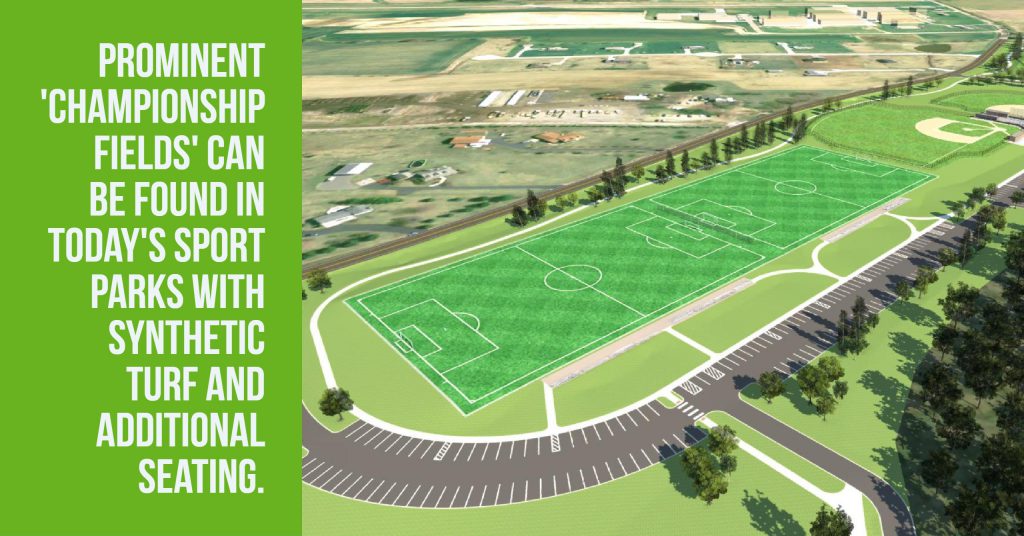
Summary
These design considerations are a fraction of the items to explore when creating a sports park. At Kleingers/Sportworks, we understand the business of sports parks, the competition that takes place inside and outside the park, and the investment owners take in creating these opportunities for revenue. We also understand good engineering, traffic, sports field engineering, survey and landscape design, and the importance of getting all of these things done right for the bottom line and ultimate success of any sports park complex.
Kleingers at the 2017 International Trail Symposium
The Kleingers Group recently spoke at the 2017 International Trail Symposium held in Dayton, Ohio. The educational conference brings together experts from all across the globe to learn more about trail system challenges, successes, and progressive ideas. We were inspired by so many ideas and conversations shared during the conference that we thought we would share some of our thoughts with you.
See our takeaways from speaking/attending below:
Sharing International Challenges and Successes
- Those in attendance during our speaking session included individuals from Brazil, El Salvador, Idaho, and New England (just to name a few). It was incredible to sit alongside others from all across the globe, discussing similar challenges, programs, and worldwide support for creating trails to connect people across the earth.
- Much like what we see in areas where we perform trail engineering and design services, many cities across the globe have been built around a single mode of transportation – cars.
- In general, Ohio has created many fantastic ‘destination trails’ where families travel by car, with bikes in tow, for recreation. Recreational communities across the state have done a great job creating these core recreation destinations. The challenge now is to create paths that connect these destinations with the people of the area.
Dayton Sets an Example for Others Across the Globe
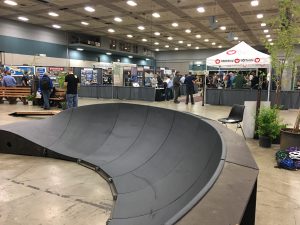
More than just trails and paths, extreme biking paths were demonstrated at the symposium.
- Dayton has such a rich history of those within the biking community. The Wright brothers and the founder of Huffy Bicycles both got their starts in the area.
- Dayton is home to the largest paved trail network in the United States.
- Following the Great Miami River flood of 1913, the Miami Conservancy District was both created and funded locally. The organization set out to build levees in the area and eventually turned its attention to focus on water activity and then trails.
- Many organizations across the country look to the conservancy as a leading example. The district has found ways to continue funding the program which helps maintain the trails in the area, including winter plowing, ADA upgrades, and more – typically a challenge for trail owners.
- The Dayton area is also known in the trail community for Huffy’s ‘Rails to Trails’ conservancy program developed in the 1970s, before converting old rail lines to bike trails was popular.
- Large metropolitan stakeholders across the globe are just now getting programs in place and look to the Dayton area as a leading example.
Changing our approach to trails through progressive examples for funding area complete streets.
- Historically, money is spent ordinarily on the right-of-way for roadways. Complete streets is a way of approaching how best to a projects’ right-of-way while generating modes of transportation and access for all-wheel riders (aside from cars).
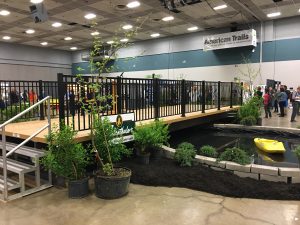
Prefabricated bridge showcased in the exhibit space.
How is The Kleingers Group affecting change in the area?
- As one example, Kleingers currently serves as the City of Wilmington, Ohio’s municipal engineer. We have been working with the city to set in place an active transportation plan which focuses on multi-modal transportation with complete street elements so that when new projects are completed within the city, they will comply with the program. The results will be a community that is not only multi-modal but a desirable place to live, work and play.
- Kleingers was recently awarded a fourth task order with ODOT for Safe Routes to Schools and Pedestrian Safety. We have an ongoing commitment to design multi-modal paths for school districts and local governments while creating a safe and healthy means of travel for students and families all across the State of Ohio.
Successful trails not only encourage healthy living and help reduce the carbon footprint; studies have shown they also increase property values for those adjacent to and in close proximity to the path. If we can consider the above successes, challenges, and creative approaches to constructing paths and trails for recreation and commuters alike, then we can (alongside others across the globe) create more desirable places to live and enjoy.